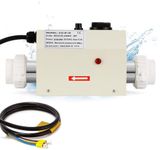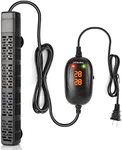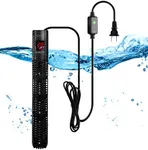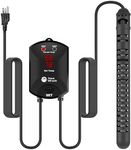Buying Guide for the Best Turtle Heater
Choosing the right turtle heater is crucial for maintaining a healthy and comfortable environment for your pet turtle. Turtles are ectothermic animals, meaning they rely on external heat sources to regulate their body temperature. A good heater ensures that the water temperature remains stable and within the optimal range for your turtle's species. Here are some key specifications to consider when selecting a turtle heater and how to navigate them to find the best fit for your needs.WattageWattage refers to the power output of the heater and determines how effectively it can heat the water. Higher wattage heaters can heat larger volumes of water more quickly. For small tanks (up to 20 gallons), a heater with 50-75 watts is usually sufficient. Medium tanks (20-40 gallons) may require 75-150 watts, while large tanks (over 40 gallons) might need 200 watts or more. Choose a heater with the appropriate wattage based on the size of your tank to ensure efficient heating.
Temperature ControlTemperature control allows you to set and maintain the desired water temperature. This is important because different species of turtles require different temperature ranges. Look for heaters with adjustable thermostats that let you set the temperature precisely. Some heaters come with built-in thermostats, while others may require an external controller. Ensure the heater you choose can maintain the specific temperature range needed for your turtle species.
Submersible vs. Non-SubmersibleSubmersible heaters are designed to be fully submerged in water, providing even heating throughout the tank. Non-submersible heaters, on the other hand, are placed outside the tank and heat the water indirectly. Submersible heaters are generally more efficient and provide more consistent heating. If you have a large tank or need precise temperature control, a submersible heater is usually the better choice.
Safety FeaturesSafety features are essential to prevent accidents and ensure the well-being of your turtle. Look for heaters with automatic shut-off mechanisms that turn off the heater if it overheats or if the water level drops too low. Shatterproof or durable materials can also prevent breakage and potential harm to your turtle. Prioritize heaters with these safety features to minimize risks.
Size and PlacementThe size and placement of the heater can affect its performance and the overall setup of your tank. Ensure the heater fits comfortably in your tank without obstructing your turtle's movement. Some heaters are compact and can be easily hidden, while others may be bulkier. Consider the layout of your tank and choose a heater that can be placed in an optimal position for even heat distribution.
Durability and Build QualityDurability and build quality are important for the longevity of the heater and the safety of your turtle. Heaters made from high-quality materials, such as titanium or shatterproof glass, are more resistant to damage and wear. A durable heater will provide consistent performance over time and reduce the need for frequent replacements. Choose a heater with a good reputation for reliability and durability.





















